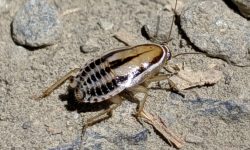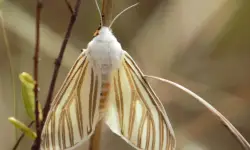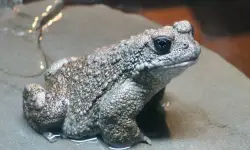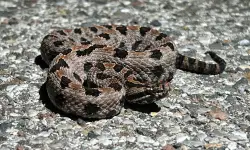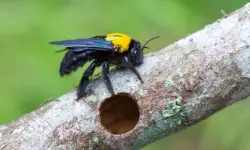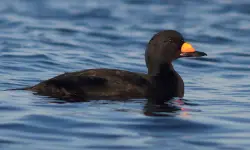Black snakes with yellow spots are a familiar sight across the US, especially in the Central and Southern regions. These snakes, varying in size from a few inches to several feet, display a striking contrast of colors that aid in their camouflage and identification.
Black snakes with yellow spots are predators; they primarily feed on smaller animals, showcasing their carnivorous nature. Interestingly, within this color pattern, there exist diverse morphs, adding to the intrigue of these common yet fascinating reptiles inhabiting a variety of landscapes throughout the country.
Different Types of Black Snakes with Yellow Spots
Gopher Snake
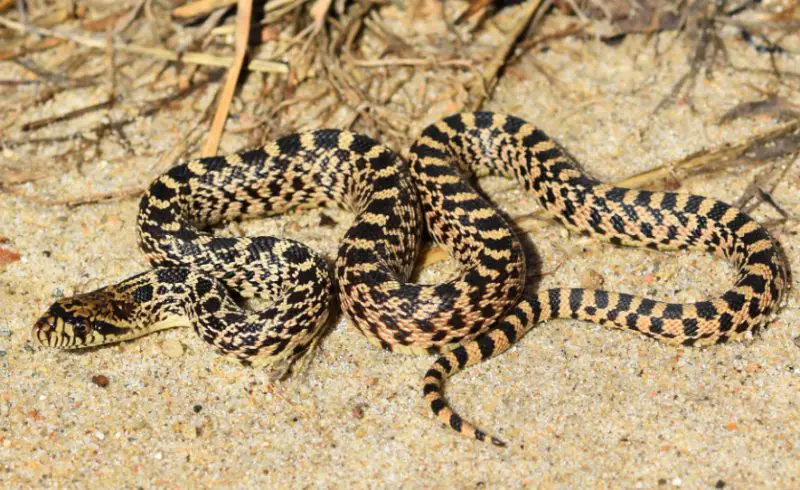
The Gopher snake (Pituophis catenifer), also known as the Pacific gopher snake or bullsnake, is often yellow with brown blotches, resembling the Prairie rattlesnake. Bullsnakes, a subspecies, are large, reaching 4 to 6 feet in length. Non-venomous, they use constriction to prey on small animals like mice and squirrels.
Although docile and reluctant to bite, they can appear threatening to deter humans. Remarkably, bullsnakes can resist and prey on venomous snakes, including rattlesnakes.
Desert Kingsnake
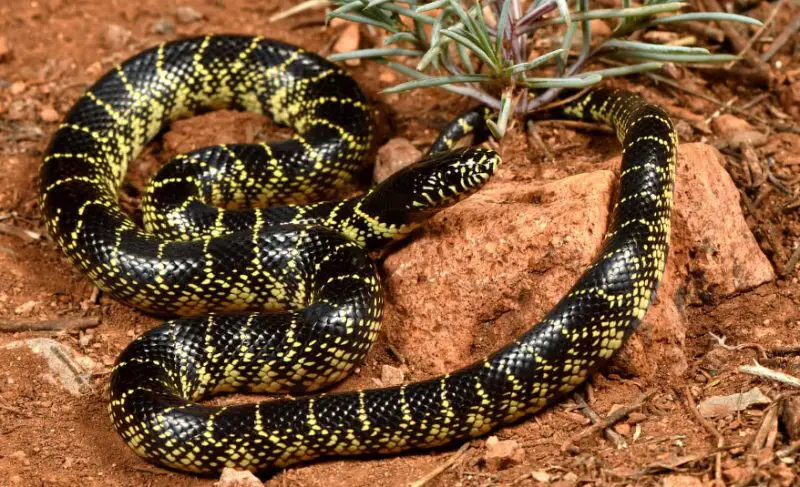
The Desert Kingsnake (Lampropeltis splendida) is distinguished by its mostly black body adorned with sparse yellow speckles, forming faded crossbands. Unlike other species, it has a black abdomen with no light coloration.
Non-venomous and known for their unique coloring and large size, they are sought after as exotic pets and are adept constrictors, capable of immobilizing and killing prey efficiently. Resilient and resistant to pit viper venom, they often prey on small rattlesnakes. In summer, females lay up to 12 eggs in sandy terrain.
Lined Snake
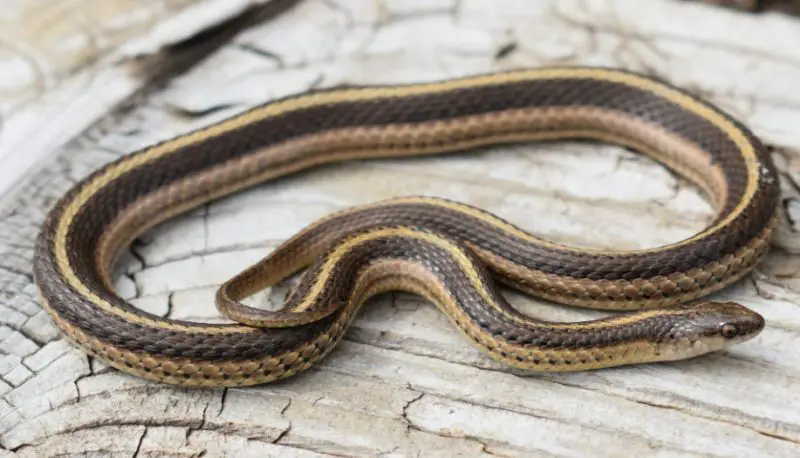
The Lined Snake (Tropidoclonion lineatum) is a lesser-known alternative to Garter snakes, particularly for those seeking a black and yellow pet. Common in Southern habitats like Texas, these snakes grow to just 15 inches with a slender body and a narrow head, aiding in underground movement.
They primarily feed on earthworms, often digging to find them, and are nocturnal, making them elusive. With good vision and vibration-sensing abilities, they emerge after rain when earthworms surface. Females exhibit a selective mating strategy, sometimes refusing to mate with certain males.
Eastern Hognose Snake
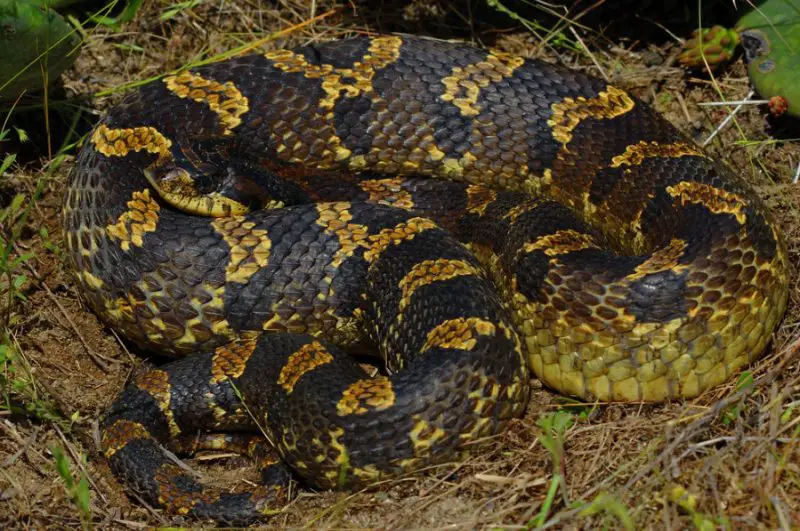
The Eastern Hognose Snake (Heterodon platyrhinos), also known as the spreading adder or hog-nosed snake, exhibits various morphs in gray, brown, or black with corresponding blotches. A notable morph features a yellow body with black and brown blotches.
This species is renowned for its defensive behaviors, such as feigning strikes and playing dead. Common in the Eastern US, they have a varied diet, including large toads. Females are oviparous, laying up to 25 eggs in sandy soils, and can be identified by their more tapered tails compared to males.
Speckled Kingsnake
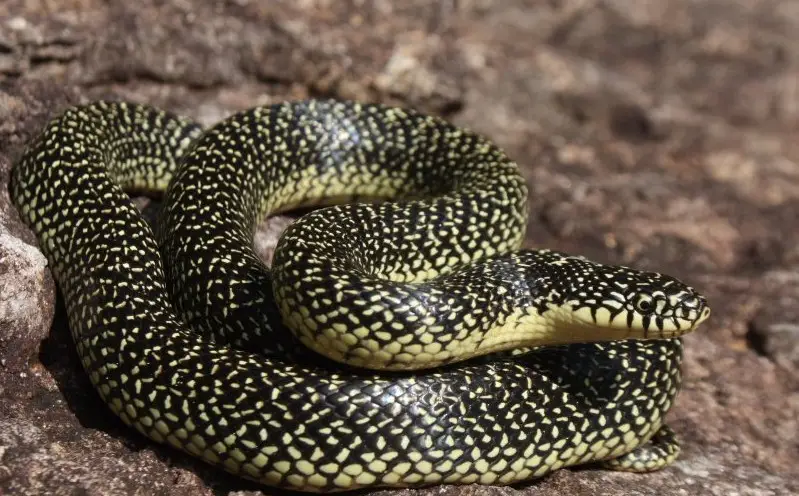
The Speckled Kingsnake (Lampropeltis holbrooki) is a common black and yellow snake in the US, named for its yellow or white specks on a black body. Reaching up to 48 inches, this thick-bodied snake is prevalent in the Central and Southern US. It hibernates in burrows or abandoned buildings in winter and is active in summer.
Known for their docile nature, Speckled Kingsnakes use tail shaking and foul-smelling secretions to deter predators. They exhibit various morphs, with the black and yellow morph being particularly widespread.
Military Ground Snake
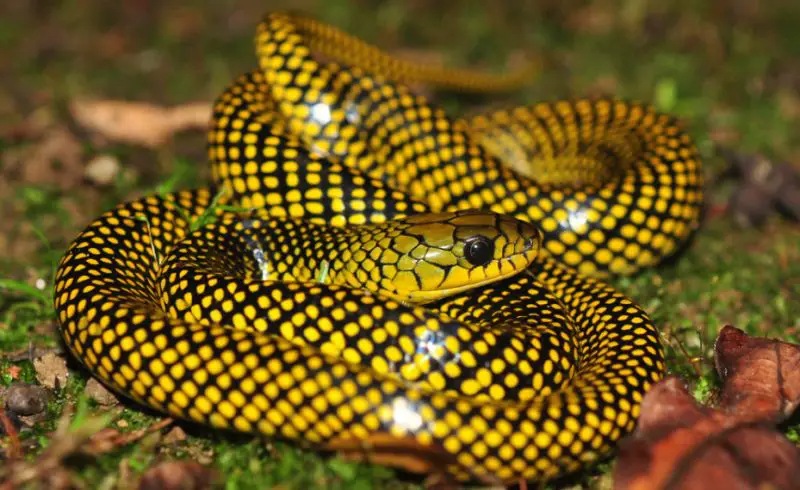
The Military Ground Snake (Erythrolamprus miliaris), also known as the common water snake, is distinguished by its black dorsal and yellow ventral coloring. Native to South America, particularly Uruguay, Brazil, and Argentina, these snakes primarily feed on invertebrates and fish.
Living deep in the Brazilian rainforest, they remain largely unstudied, with mating behaviors and feeding preferences still under investigation.
Females, larger than males, exhibit selective mating behavior, with mating influencing their desire to eat. Maturing at 2 to 4 years, they reach about 20 inches in length.
Banded Krait
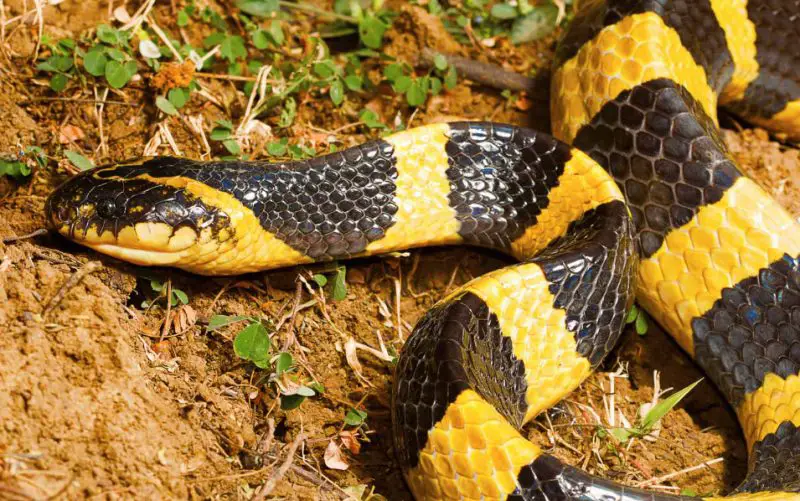
The Banded Krait (Bungarus fasciatus) is native to Southern Asia, commonly found in Thailand, Cambodia, and neighboring countries. Sporting distinctive black and yellow crossbands and a similarly patterned head, they inhabit grasslands and forests away from human settlements, being primarily nocturnal.
Known for preying on other snakes and fish, they possess highly potent neurotoxic venom, making them one of the deadliest black and yellow snakes. Immediate medical attention is crucial for victims, as untreated bites can lead to death within 24 hours. Handling should be avoided due to the snake’s lethality.
Texas Coralsnake
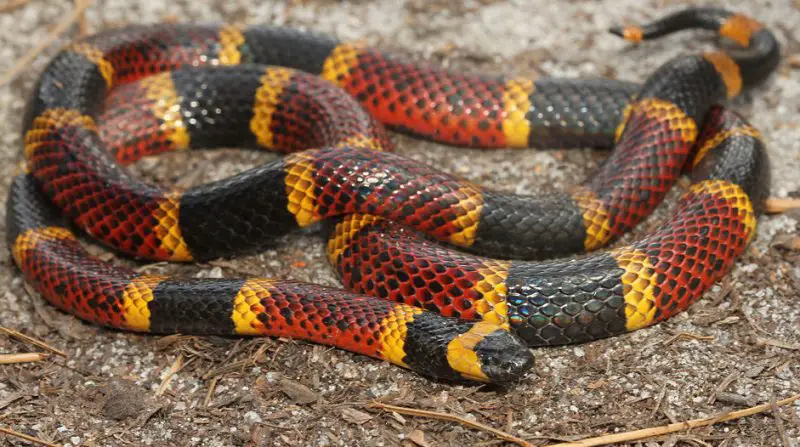
The Texas Coralsnake (Micrurus tener) is found in Southern US states and Mexico. This highly venomous snake features bright yellow bands and faded red-brown blotches on a mostly black body. Its potent neurotoxin can cause significant pain and neuromuscular issues, though fatalities are rare.
Despite this, its vivid coloration and venomous nature make it a feared species. Consequently, at least two other snake species in the Southern US mimic its coloring for protection.
Black Kingsnake
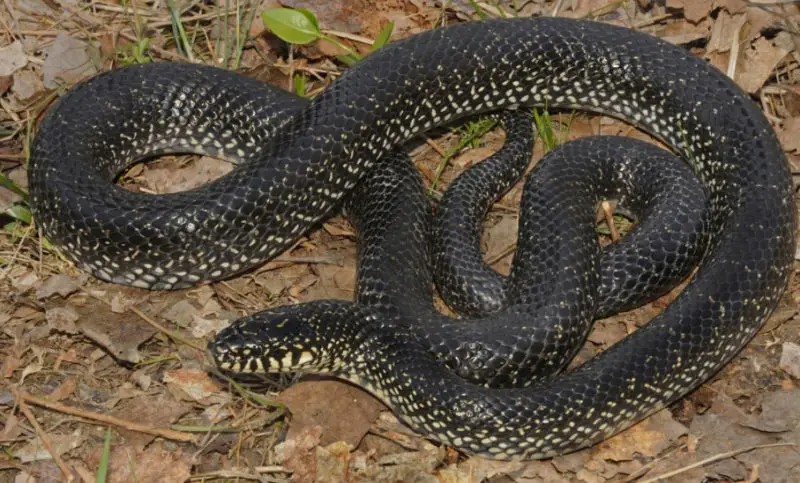
The Black Kingsnake (Lampropeltis nigra) is almost entirely black with a yellow underbelly, distinguishing it from the all-black Mexican Black Kingsnake. Common in the Southern US, it inhabits mountains, crops, and woodlands. Growing up to 48 inches, this constrictor suffocates small mammals like rodents.
Black Kingsnakes thrive in abandoned farmlands, where rodent populations are high, making them easy to spot for those seeking black and yellow snakes. They often share their habitat with other snake species.
Eastern Patch-nosed Snake
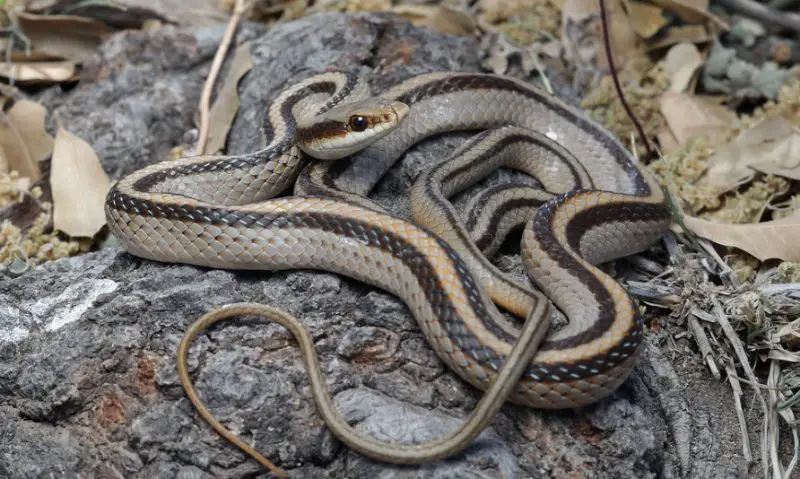
The Eastern Patch-nosed Snake (Salvadora grahamiae), also known as the Mountain Patchnose Snake, is distinguished by a unique scale on its snout. It exhibits various subspecies and morphs, many featuring black and yellow stripes.
Notable subspecies include the Texas Patch-nosed snake and the Desert Patch-nosed snake, both characterized by green-black bodies with yellow stripes. This species is known for its distinctive color patterns.
Striped Whipsnake
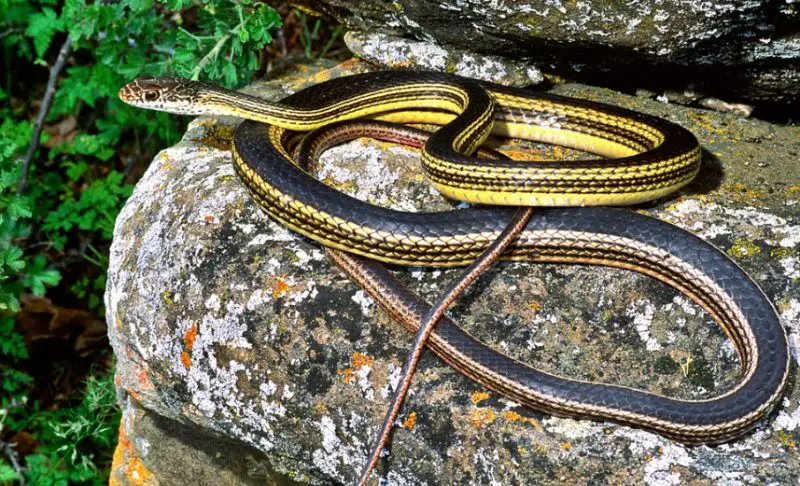
The Striped Whipsnake (Masticophis taeniatus) can grow up to 72 inches and is often seen in black and yellow, with hints of olive or green. This snake’s black dorsal color and pale yellow stripes provide camouflage in its habitat, which includes grasslands, woodlands, canyons, and pine-oak forests in Texas and Southern territories.
Striped Whipsnakes use rocky terrains and rodent burrows for shelter. They are generalist feeders, consuming insects, frogs, and even other snakes, including venomous ones.
Garter Snake
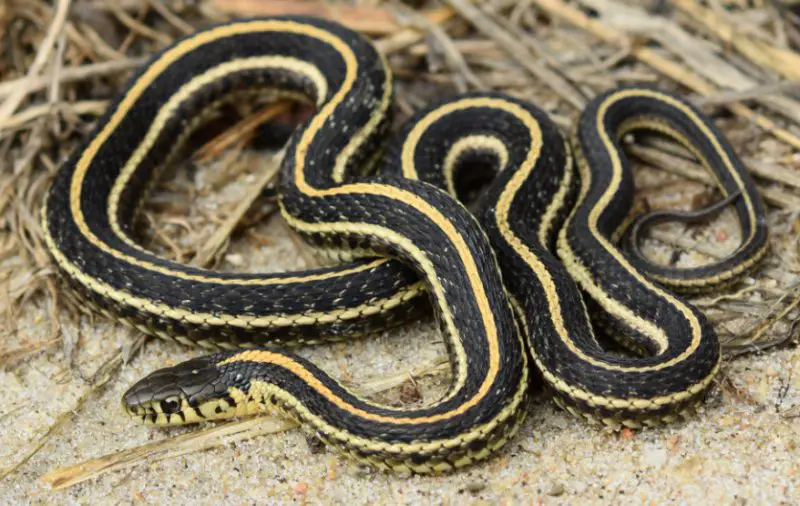
The Garter snake, with the scientific name Thamnophis, is known for its black and brown scales and a central yellow line along its body. Common in the US, particularly in states like Iowa, it thrives in moist habitats and populated areas like parks and homes.
Garter snakes have a diverse diet, including dead animals, and are diurnal, making them active and visible during the day. They often overwinter with other snake species.
Western Patch-nosed Snake
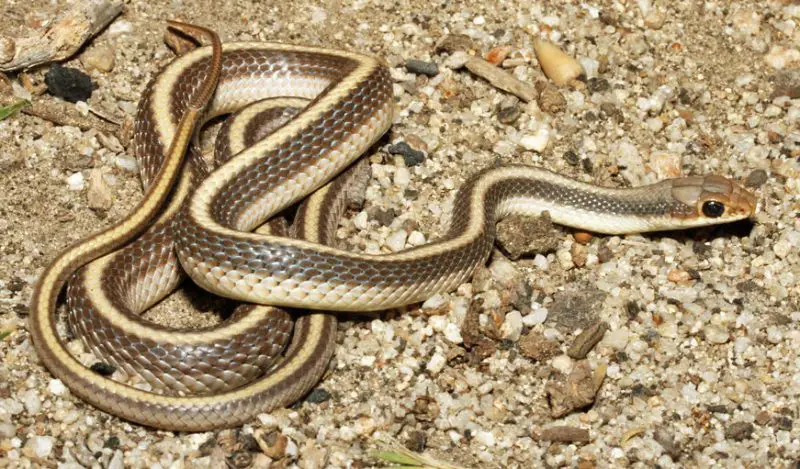
The Western Patch-nosed Snake (Salvadora hexalepis), named for the patch-shaped scale on its nostril, grows up to 3 feet long. It features a black body with yellow and white stripes, with some morphs having a completely white underbelly. Inhabiting desert scrublands in the Southwestern US and Mexico, this diurnal snake is easily spotted in arid environments.
Unlike constrictors, it immobilizes prey by lying on top. Agile and adept at detecting smells, it can dig up eggs and climb vegetation. Females lay up to 10 eggs in the summer.
Eastern Foxsnake
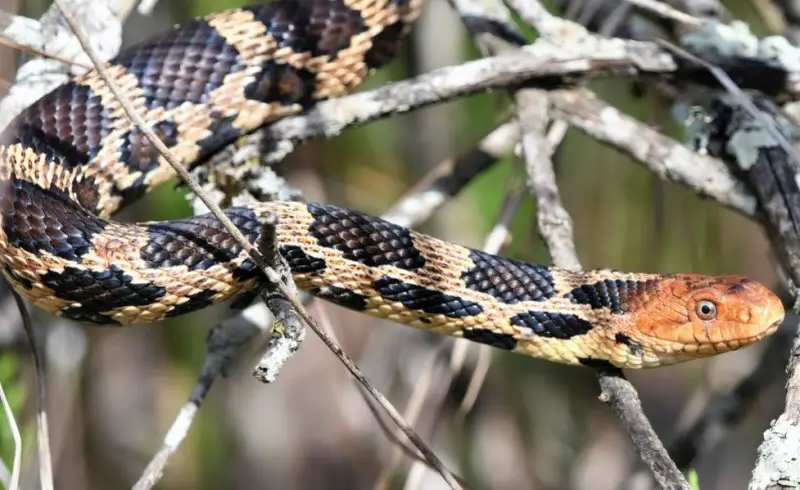
The Eastern Foxsnake (Pantherophis vulpinus) is typically yellow with black or brown blotches, though it comes in various morphs. Its similar size to copperheads often leads to confusion, exacerbated by its tail-rattling behavior resembling rattlesnakes. However, Eastern Foxsnakes rarely bite and are non-venomous.
Fairly docile with a robust body, they can climb to escape predators. Unfortunately, human encroachment on their grassland habitat and their mistaken identity as venomous snakes pose significant threats to this species.
Resplendent Desert Shovel-Nosed Snake
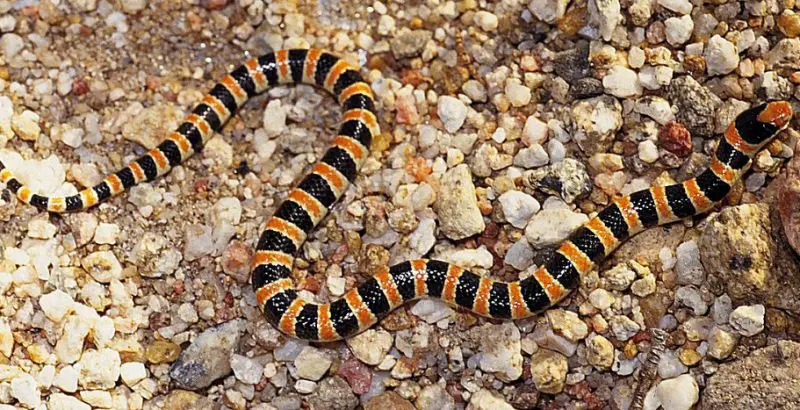
The Resplendent Desert Shovel-Nosed Snake (Chionactis annulata) is a slender black and yellow species primarily found in California, Arizona, and Baja California. Growing up to 11 inches, it features a yellow base color with black bands that stop at the underbelly. Adults typically exhibit yellow and black coloration, while some morphs include yellow, black, and red bands.
Resembling venomous coral snakes, they’re non-venomous but can inflict painful bites. Mostly nocturnal, they hide under rocks during the day, making them rarely seen by humans.
Mohave Shovel-Nosed Snake
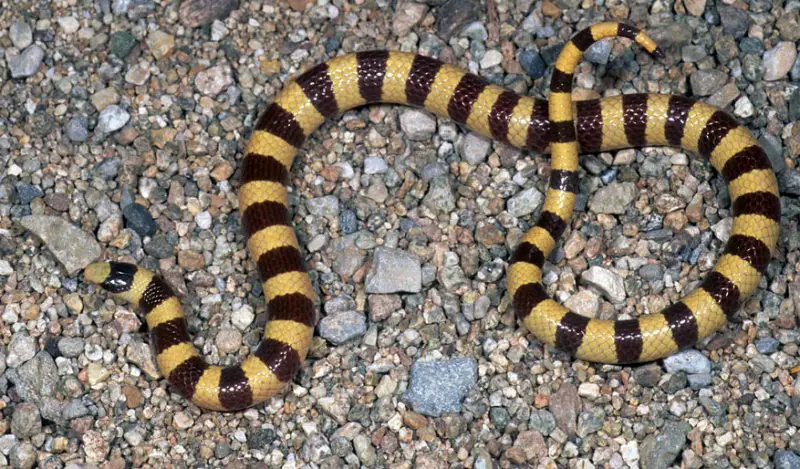
The Mohave Shovel-Nosed Snake (Chionactis occipitalis) is exclusive to the Mohave region, characterized by its slender body and distinctive black and yellow coloring. Growing up to 17 inches, it features equal proportions of bright yellow and dark bands running from head to tail.
Common morphs include black with thin yellow and red rings. With a thin head and nocturnal habits, they prefer sandy and rocky terrains in the Mojave Desert and Baja California, making them elusive to spot.
Snail Sucker
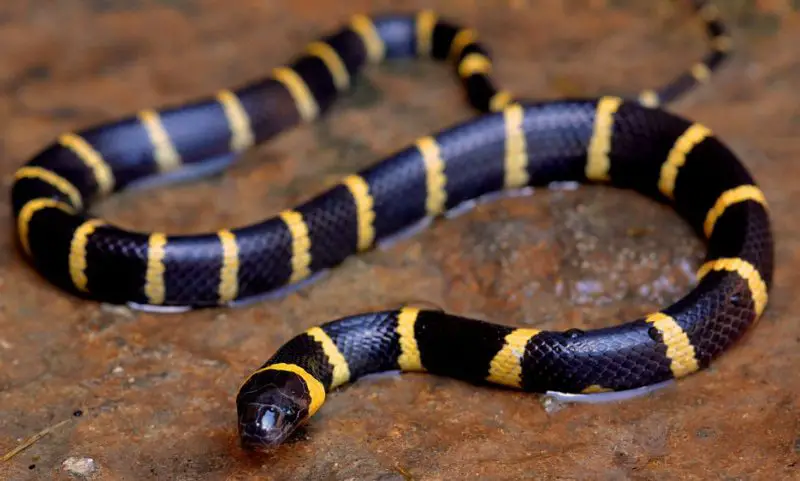
The Snail Sucker (Geophis sartorii), belonging to the Colubridae family, is distinguished by its mostly black body adorned with deep yellow rings. Preferring Central American habitats, recent discoveries have revealed populations in Peru. Named for its unique mouth adaptations, which allow it to extract snails from their shells, this species is primarily found in tropical forests.
Research suggests that habitat type influences both their appearance and mating success, with females in Atlantic-close forests believed to have higher mating success.
Tiger Snake
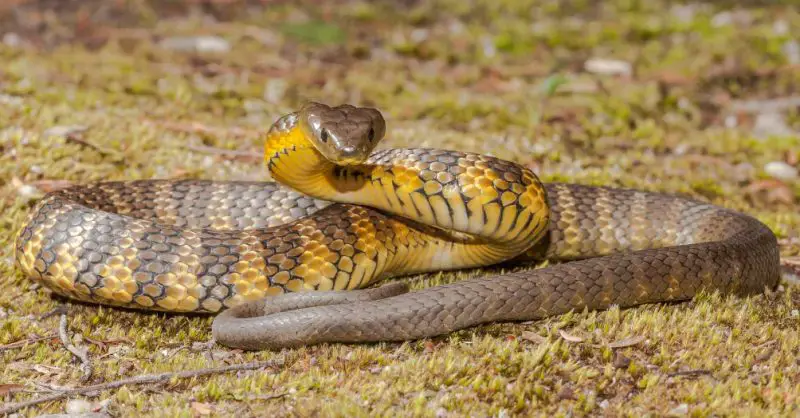
Tiger Snakes (Notechis scutatus) are among Australia’s most common venomous species, with various subspecies and morphs. The Western Tiger Snake, for example, displays black and yellow coloring with a yellow underbelly. While bites are not usually fatal, immediate medical attention is crucial.
Treatment protocols resemble those for other venomous snakebites, but mortality rates are high without proper care. In many countries, killing these snakes is illegal; they are protected in Australia, though not in Tasmania.
Northern Cat-eyed Snake
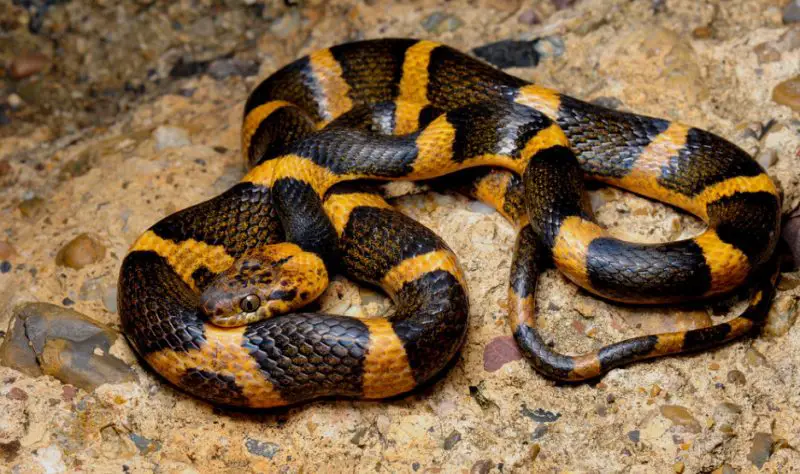
The Northern Cat-eyed Snake (Leptodeira septentrionalis) is found in North and Central America. It has a yellow underbelly and a brown and black dorsal side. It is mildly venomous; its venom can kill small animals but is not lethal to humans in small amounts.
It preys on frogs, using venom to kill larger ones while swallowing smaller frogs directly. Arboreal and nocturnal, it lays up to 13 eggs, which hatch in 2–3 months. Warmer climates in Central America can lead to more frequent egg-laying.
Chicken Snake
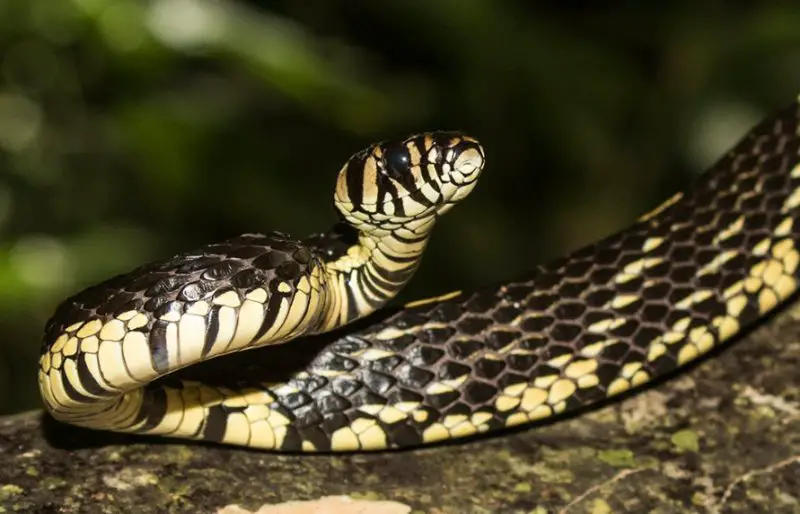
The Chicken Snake (Spilotes pullatus), also known as caninana, tiger rat snake, yellow rat snake, and serpiente tigre, is notable for its mostly yellow body with some black scales. It has a flattened body, a large head, and brown to black head markings. Named for its diet of small birds, it also eats lizards.
This diurnal and nocturnal snake prefers trees, where it finds birds and eggs, but it can also live on the ground if food is available. Common in Central and North America, it is highly territorial, with males often competing for females, who ultimately choose their mate.
Yellow-bellied Liophis
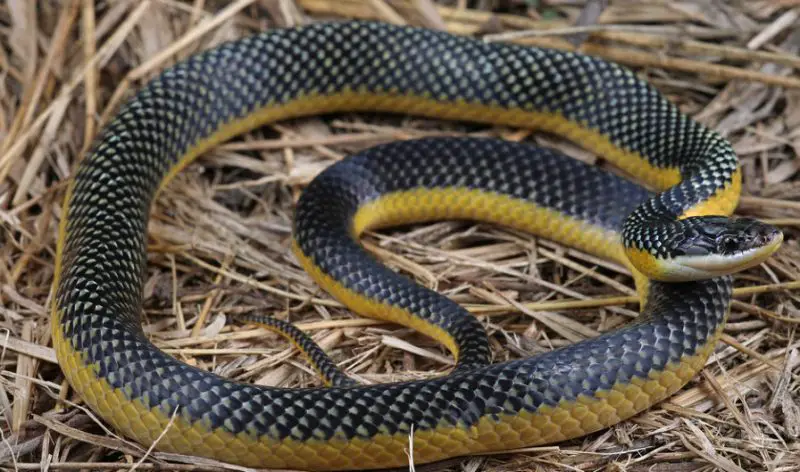
The Yellow-bellied Liophis (Erythrolamprus poecilogyrus) is a snake from the Dipsadidae family commonly found in South America. Popular in the pet industry for its striking black and yellow coloration, it often has a completely yellow underbelly and a black dorsal side. This terrestrial snake can also swim and prefers to avoid humans.
It feeds on tadpoles and, as juveniles, insects. Despite its high reproductive rates in captivity, much about its natural life and habitat remains unknown due to limited studies.
Western Black-tailed Rattlesnake
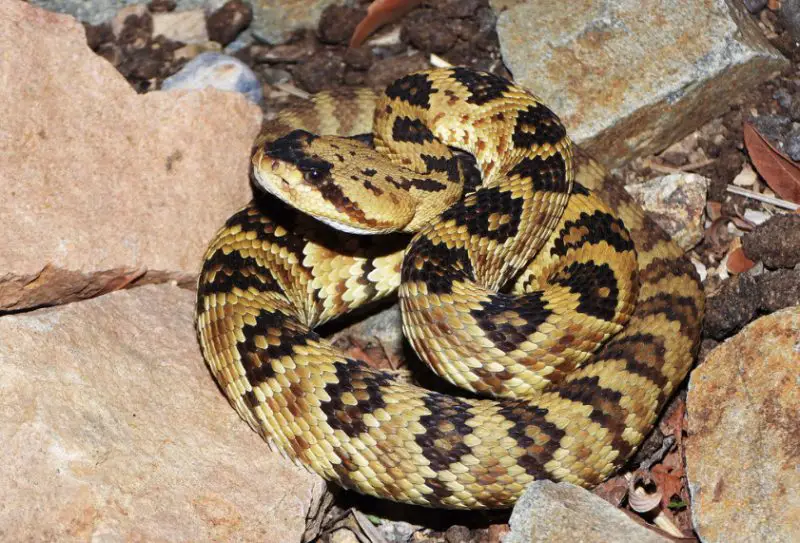
The Western Black-tailed Rattlesnake (Crotalus molossus), also known as the black-tailed rattlesnake, is one of the least poisonous rattlesnakes. Found in the Southwestern US, this species comes in various colors, including black, yellow, gray, and green. Generally docile and non-aggressive, its hemotoxic venom rarely poses a significant threat.
Nocturnal in the summer to avoid heat, it hunts rodents at night, and it becomes diurnal in winter, basking on rocks. Despite its venom, it is less dangerous than that of many other rattlesnake species.
Ribbon Snake
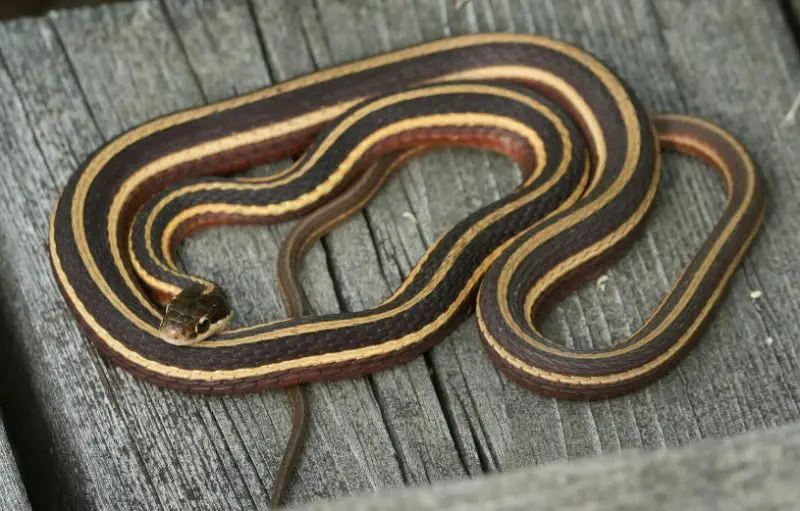
The Ribbon Snake (Thamnophis saurita) is native to Northeastern US territories. It features a gray, olive, or black color with yellow stripes and grows to 16–35 inches. Ribbon snakes are selective predators with keen vision, vibration sensing, and some auditory abilities, enabling them to detect prey quickly.
They feed on reptiles, newts, salamanders, worms, and spiders. Juveniles, often preyed upon by hawks, mature in 2–3 years. Females give birth to live young, with up to 27 offspring that start feeding on spiders and insects soon after birth.
Western Ribbon Snake
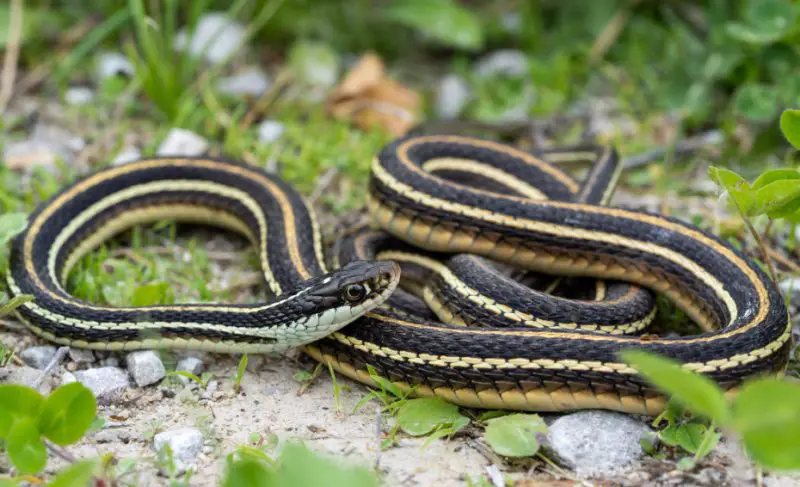
The Western Ribbon Snake (Thamnophis proximus) is a black and yellow or gray and yellow species commonly found around water sources. Known for their longevity, they can live up to 20 years in captivity. They reach sexual maturity quickly, being ready to reproduce within 12 months.
Amphibians, particularly frogs, are a preferred food source. These snakes use a unique hunting technique, performing three fake strikes to flush frogs out of hiding. This method exploits the frog’s instinct to react, revealing its location.
Yellow-Bellied Sea Snake
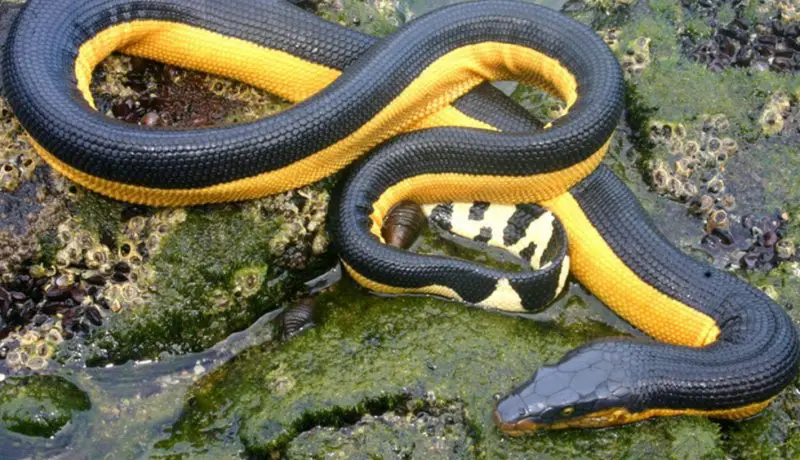
The Yellow-Bellied Sea Snake (Hydrophis platurus) is a widely distributed species known for its distinctive black body and yellow underside. These snakes are prevalent in seas worldwide, except in the Atlantic Ocean, and live far from shore.
Feeding on a variety of fish, they are efficient swimmers and are also known to consume dead fish in captivity. Despite their small size, their venom contains potent neurotoxins that can cause paralysis and, in rare cases, be fatal to humans.
Saltmarsh Snake
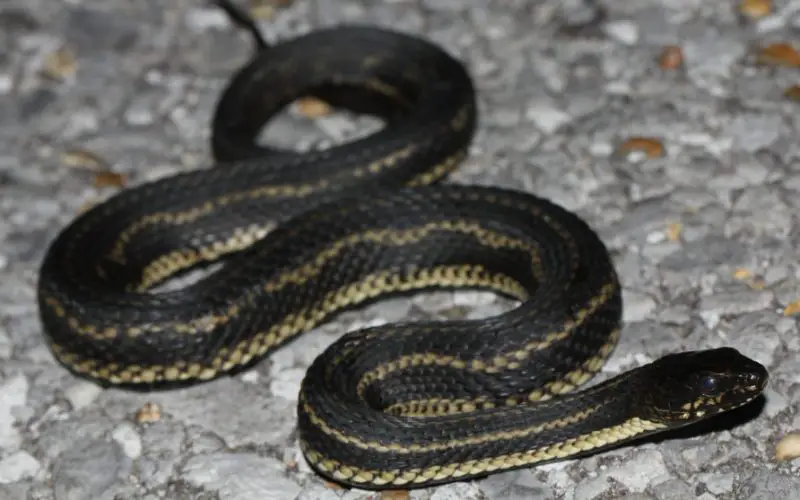
The Saltmarsh Snake (Nerodia clarkii) is primarily found in Florida, particularly around Tampa Bay and Miami, where it inhabits saltwater estuaries for feeding and breeding. With various color morphs, including black and yellow, red and brown, or black and gray, these snakes typically give birth to live young in late August.
Despite their non-venomous nature, they face threats from habitat loss due to construction and mistaken identity, as some are killed by people who confuse them with venomous cottonmouths. Adapted to nocturnal feeding, they often hide in crab or mud burrows during the day.
Gold-ringed Cat Snake
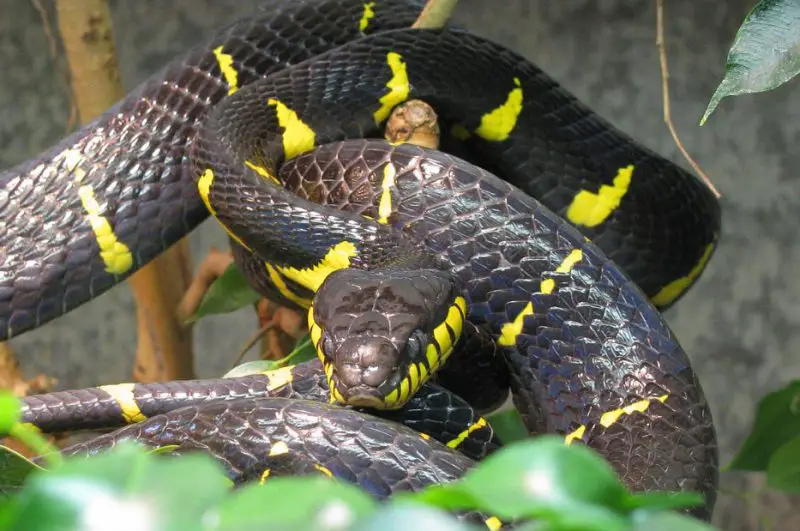
The Gold-ringed Cat Snake (Boiga dendrophila), also known as the Mangrove Snake, is a venomous Colubrid species found in Borneo. Recognizable by its striking black and deep yellow coloring, it grows up to 7 feet in length.
Feeding on rodents and small animals, it’s not an ideal pet due to its aggressive and nervous disposition. Handlers risk repeated strikes, some of which may be venomous. Consequently, it’s best admired from a safe distance in its natural habitat.
Ring-necked Snake
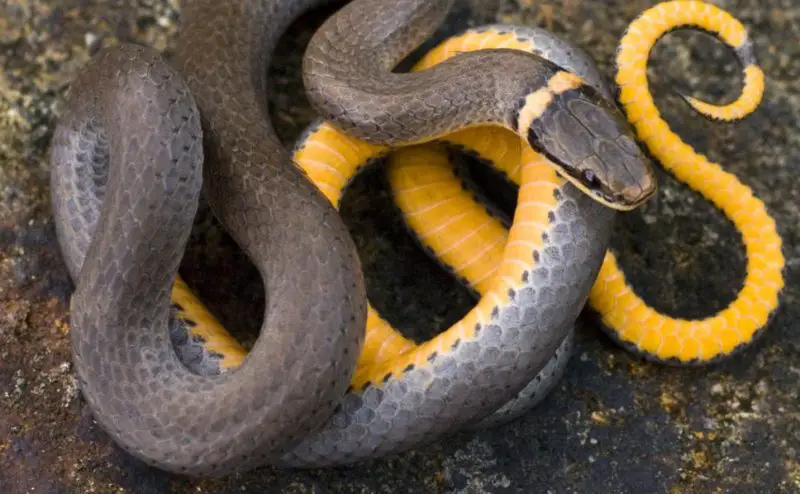
Ring-necked snakes, scientifically known as Diadophis punctatus, are commonly found across the Pacific Coast. Named for the distinctive ring-like marking around their necks, they exhibit various color morphs, including black and yellow or gray and orange.
Despite their small size, they are skilled predators, preying on insects, earthworms, and salamanders. Their venomous saliva aids in immobilizing their prey, making them effective hunters. As juveniles, they can resemble worms, contributing to their success in capturing prey.
Striped Racer
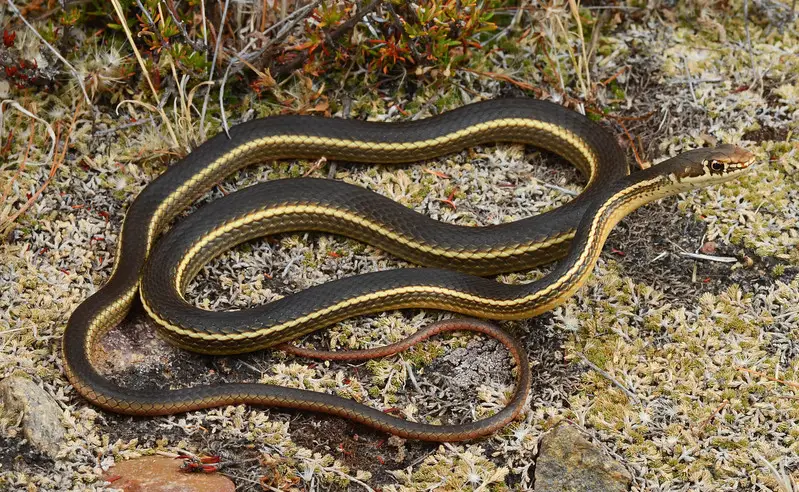
The Striped Racer, or Masticophis lateralis, is a native Californian snake known for its black and yellow coloring. It also comes in green or gray with yellow markings. While non-venomous, it’s highly aggressive and may bite when handled.
Found in arid terrains, grasslands, woodlands, and canyons, it preys on insects as juveniles and small mammals as adults. Growing up to 40 inches, these snakes are fast-moving and elusive, making sightings rare in their natural habitat.
California Kingsnake
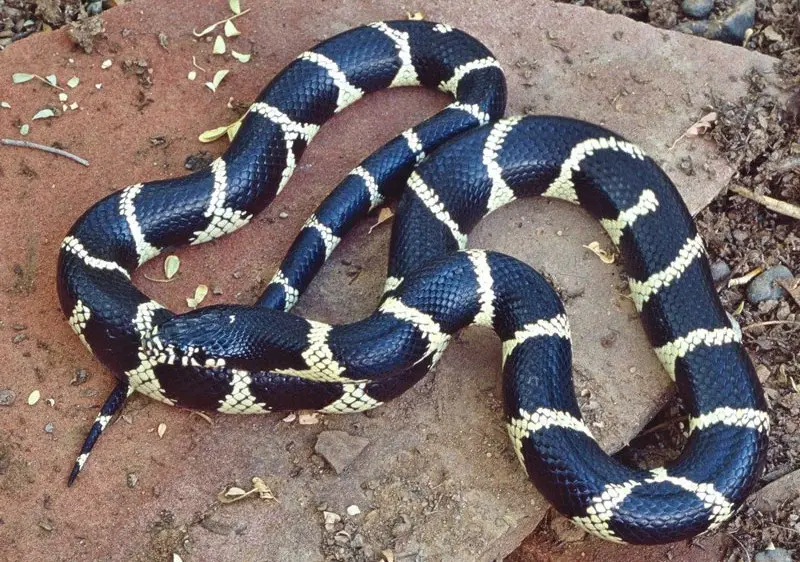
The California Kingsnake, or Lampropeltis californiae, is prevalent in chaparral and woodlands, boasting various morphs beyond its black and yellow coloring, including shades of brown. As constrictors, they prey on frogs, lizards, and mice, suffocating them by entanglement.
Typically reaching sexual maturity by age 4, they engage in mating behaviors akin to Common Kingsnakes, with males biting females during mating. Females lay up to 24 eggs in the summer, which hatch in the fall, though clutch sizes can vary.
Common Kingsnake
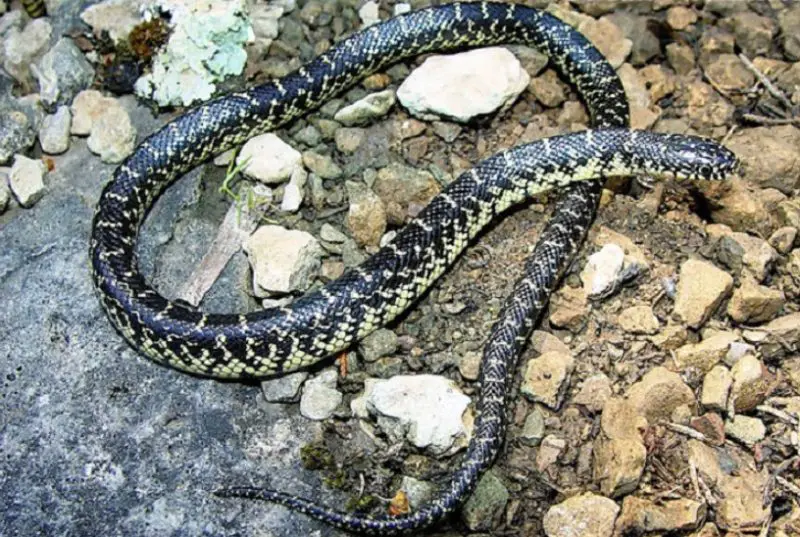
The Common Kingsnake, or Lampropeltis getula, is prevalent across several Southeastern states, showcasing black and yellow coloring that varies by region. Some exhibit prominent yellow speckles or rings, while others are predominantly black. Known as adept constrictors, they prey on small mammals and even other snakes, including venomous species like rattlesnakes.
Common Kingsnakes are resilient to venom and reproduce prolifically, with females laying up to 25 eggs underground. Their mating behavior is marked by aggressive male biting during copulation.
Arizona Black Rattlesnake
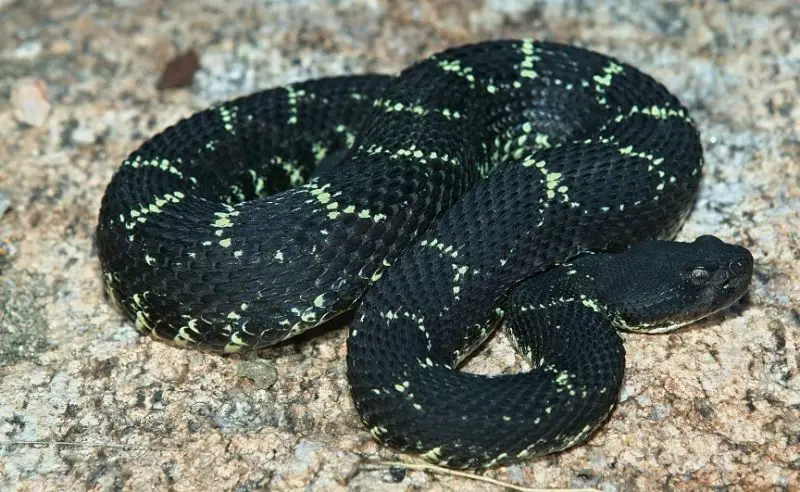
The Arizona Black Rattlesnake, or Crotalus cerberus, presents a challenge in identification due to its color-changing ability, primarily driven by mood. Sporting a black body adorned with scattered large yellow scales, it’s a highly venomous species, comparable to other rattlesnakes. Some individuals display heightened aggression.
Often found in woodland areas, particularly humid spots like under leaves, they exhibit social behavior, choosing group living. Rarely confrontational, they may rattle as a warning before biting, necessitating immediate medical attention for their potent venom and long fangs.

